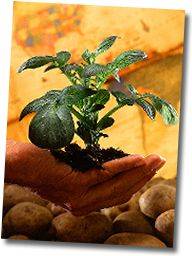Seed
Successful establishment of quality turfgrass can be difficult
in certain regions. The extremes in temperature and moisture availability create
severe stresses on both cool- and warm-season grasses. The humidity promotes
increased fungal activity. When this is coupled with the stresses created by the
difficult climate, all turfgrass plants have difficulty surviving. Therefore,
selecting the appropriate turf and method of establishment requires some
forethought.
Quality seed establishment has several advantages:
-
Cheap initial establishment cost
-
Wide variety selection
-
Low labor requirement
-
Less time for job completion
-
Ease of establishment in difficult areas.
Soil preparation for establishment is the same whether the
homeowner is sodding or seeding; therefore, since seed costs less, the initial
establishment cost will be less if an area is seeded. When utilizing seed, an
infinite number of mixture possibilities are available unlike sod. Seed
establishment requires less labor and time than sodding. Because of difficult
access in some areas, hydroseeding may be the only reasonable solution. In
hydroseeding, a fertilizer/seed slurry is spread over the area.
Some disadvantages of seeding to consider before making a
final decision are:
-
An erosion potential during the establishment stage
-
The time lag before the area will be usable
-
The need to reseed areas which do not establish well
-
The need for seedling weed control
-
Limited desirable seeding periods
-
Necessity of frequent watering during germination
-
The fact that tangible, end-product quality cannot be
purchased.
Seeding should not be considered in lawn areas where the
probability of erosion is high. When seeding Kentucky bluegrass mixtures, one
should assume that with a fall seeding the area will not be ready for heavy use
before late May. Extra money for reseeding the areas that do not establish well
should be considered from the start. Herbicides may be necessary in the first
year after seed establishment and should be included in the computation.
Cool-season grasses are normally only successfully established from August 15 to
the middle of October and from February 30 to April 15 in the spring. This
limits the usefulness of seed in some situations. Frequent, light irrigations
are necessary with tender seedlings. In seeding, the highest quality seed can be
purchased, but remember, there are many factors that can reduce the quality of
the end product. Seed is the most reasonable solution to the establishment
problem when:
-
Cost of initial establishment is an extremely limiting
factor
-
There is no rush for the finished product
-
Erosion is unlikely
-
The area is inaccessible.
If you decide to seed, be sure to purchase quality certified
seed. Contact your local Extension office for specific information about the
types of quality certified seed available in your area.
Sod
Advantages and disadvantages of each method of lawn
establishment should be considered. The advantages of a quality sodding include:
-
Immediate erosion control
-
An instant green surface with no dust or mud
-
Year-round establishment capability (whenever the ground is
not frozen)
-
Reduced probability of establishment failure
-
Freedom from weeds
-
Quick-use capability
-
A tangible quality that can be purchased.
Sod installation provides a mature turf which has less
probability of failing than a new seeding. Quality sod will be weed-free,
whereas any new seeding will have some weed invasion. Sod is normally usable
within two to three weeks. When consumers make a decision to buy sod, they can
see the product they are buying, but when purchasing seed, there is great
difficulty in estimating the turf quality of the end product.
Sodding may have advantages, but it has problems, too. The
initial expense of sodding is prohibitive for some. The limited sod mixture
selection may be a handicap in certain environments such as shade or where one
desires exotic varieties. The successful rooting of sod is dependent upon many
factors. It has been observed that Kentucky bluegrass has difficulty rooting in
the early summer after seed-head inflorescences have emerged. Summer sod
installation of cool-season grasses such as bluegrass can be successful if
irrigation and sod-bed preparation are adequate.
Situations where sod is the obvious answer to the
establishment problem include :
 |
Where immediate erosion control is required
|
 |
Areas which need to be quickly functional
|
 |
Where the need for established turf does not correspond to
successful seeding times |
 |
If there is a need for a quick, tangible quality or
immediate property value increase. |
Sodding is frequently considered to be an expensive means of
establishing turfgrass; however, if one is careful to consider the total cost of
a seeding, especially in situations where seeding is being used in marginal
areas, the cost of sodding can often be cheaper in the long run.
![]() Gardeners' Corner
Kids'
Garden
Sustainable Garden
Contact Us
Gardeners' Corner
Kids'
Garden
Sustainable Garden
Contact Us![]()

